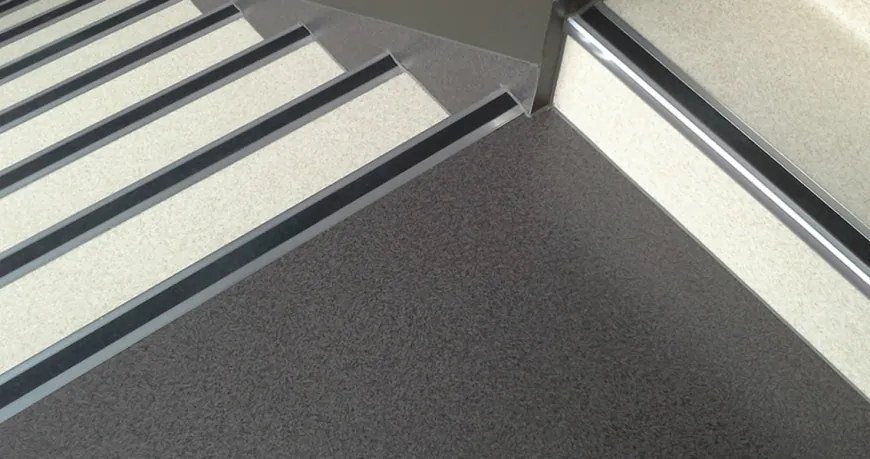Enhancing Safety through Precautionary Measures: Stair Nosing
Stair Edgings are the strips or edges installed at the leading edge of each stair tread. They are a vital safety feature that helps prevent slip and fall accidents on staircases.

What are Stair Edgings?
Stair Edgings are the strips or edges installed at the leading edge of each stair tread. They are a vital safety feature that helps prevent slip and fall accidents on staircases. Nosing make the stairs more visible especially in subdued lighting conditions and also help people using the stairs to identify the edge of each step.
Types of Stair Edging Profiles
There are different types of Stair Edging profiles available based on the material and design:
Round Nosing
Round nosing have a curved profile and are the most common type installed on residential staircases. Their smooth rounded shape reduces the chances of tripping. However, they provide less visual definition of each step edge.
Angle Nosing
Angle nosing have a beveled angled profile. They offer better visibility of the step edges compared to round nosing. But their sharp edges can pose trip hazards if not installed properly.
Bullnose Nosing
Bullnose nosing have a semi-rounded profile that provides the best of both worlds. They are not too rounded like round nosing but also don't have sharp edges like angle nosing. This makes them a popular choice for commercial spaces.
Material Options for Stair Edgings
Along with the profile, material selection is also important based on the location and traffic of the Stair Nosing. Some common materials used for Stair Edgings include:
Aluminum
Aluminum nosing are lightweight, durable, and corrosion-resistant. They are a popular choice for high traffic commercial settings like hospitals and schools.
Brass
Brass nosing have high durability but they can get slippery over time if not treated with non-slip coatings. Regular maintenance is required.
Plastic/Rubber
Plastic and rubber nosing are cost-effective, non-slip even when wet, and require very low maintenance. However, they have a shorter lifespan than metal nosing.
Stainless Steel
Stainless steel has high strength and is highly resistant to corrosion, moisture, and chemicals. It is commonly used in industrial settings and swimming pool areas.
Carpet/Vinyl
Carpet and vinyl nosing offer excellent traction but they cannot be reused if the carpet wears out. Also, they are not suitable for outdoor staircases.
Installation Tips for Stair Nosing
Here are some best practices for ideal installation of Stair Edgings:
- Ensure proper cleaning of stair treads before securing nosing.
- Use recommended adhesive for the specific nosing material as per manufacturer instructions.
- Apply adhesive in continuous thin beads or spots across the full tread width and press nosing firmly into position.
- Check nosing regularly for any lift-edges after full adhesive cure and touch up with additional adhesive if needed.
- For metal nosing, apply non-slip coatings as per requirements to prevent wear over time.
- Install bullnose or radius nosing in rounded stair tread ends for safety.
- Provide adequate lighting, including nightlights, on stairs for visibility of contrasting nosing.
Proper installation is key to ensuring Stair Edgings serve their intended safety purpose for many years. Even minor imperfections in securing nosing can compromise their slip-resistant properties.
Choosing the right Stair Nosing Overview profile, material and colors combined with following installation best practices can go a long way in preventing accidents and keeping staircases safe for all users. Stair Edgings are a deceptively simple but extremely effective way to guard against falls - one of the leading causes of accidental deaths. When specified and installed as per standards, they fulfill their job of protecting lives to the fullest.
Stair Edging Standards and Regulations
Stair Edgings must comply with building safety codes and ADA guidelines to ensure accessibility for all. Some key regulatory requirements regarding Stair Edgings include:
- Nosing shall have a slip-resistant surface to prevent slips, especially when wet or contaminated.
- Projection of nosing beyond the tread edge should be minimum 1/2 inch to maximum 1-1/4 inches.
- Open risers are not permitted for stairs with impervious surfaces like concrete where materials could fall through.
- Visual contrast should be provided between treads and nosings through different colors or materials to define each step edge clearly.
Properly installed, code-compliant Stair Edgings thus improve stairs safety for all building occupants including senior citizens and those with mobility issues or visual impairments. They play a critical role in preventing falls - one of the leading causes of accidental deaths globally.
Get more insights Stair Nosing
For Deeper Insights, Find the Report in the Language that You want
About Author:
Ravina Pandya, Content Writer, has a strong foothold in the market research industry. She specializes in writing well-researched articles from different industries, including food and beverages, information and technology, healthcare, chemical and materials, etc.












